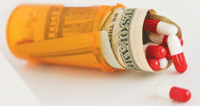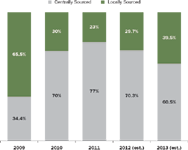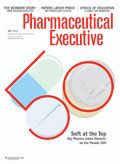Tracking Trial Cost Drivers: The Impact of Comparator Drugs and Co-Therapies
Pharmaceutical Executive
New research from the Tufts Center for the Study of Drug Development identifies a significant contributor to the rising cost of clinical trials-the first step in meeting a growing strategic imperative to help senior management and the regulatory community craft new approaches to make trials more efficient in delivering results to clinicians and patients.
Drug supply professionals concur that the increasing use of comparator drugs and co-therapies in clinical studies acts as a strong counter to company efforts to rein in the rapid growth in drug development spending. TransCelerate Biopharma, a consortium of 10 Big Pharma companies committed to improving the overall efficiency of the R&D process, is putting new focus on the high cost and incidence of comparator drugs and co-therapies in clinical trials.

Photo: Thinkstock
The current climate reflects intensifying market competition and regulatory reform as more trials are being conducted to compare the safety and efficacy of investigational treatments against a standard of care. Although comparative effectiveness studies of new drugs are still relatively new, sponsor companies are including commercial comparator drugs in their clinical studies to position their drug against a competitor. In some cases, regulatory authorities still require comparisons with a placebo. However, as sponsor companies target more difficult chronic and terminal illnesses, comparisons with a placebo may be unethical, making a commercial comparator drug necessary. Moreover, many clinical trials now test the efficacy and benefits of co-therapies on diseases that have historically not responded well to single therapies (e.g., HIV and oncology).
Based on a decade of experience, investigational drug supply chain professionals note that sourcing and managing comparator drugs and co-therapies is difficult, risky, and costly. The cost to acquire comparator drugs and co-therapy drugs is high as study sponsor companies often must pay retail prices instead of wholesale or discounted prices. In many instances, sponsor companies are unable to secure comparators and co-therapies directly from a competitor. As a result, sponsors must rely on vendors/wholesalers and the principal investigators at each research center to purchase comparator and co-therapies, and also through local pharmacies. As newer and more sophisticated therapies enter the market (e.g., biotherapeutics and stem cells), the cost for comparator and co-therapies is expected to escalate sharply. Also, the supply of these products will likely be curtailed due to the complex manufacturing processes.
Sourcing comparator drugs and co-therapies often results in substantial delays and increased study cycle time. Planning and managing decentralized global sourcing activity poses logistical challenges—particularly with comparator drugs and co-therapies requiring unusual storage and shipping requirements. Obtaining comparator and co-therapy product documentation, handling resupply shortages and delays, and maintaining supply chain security particularly against counterfeit drugs are but a few of the many challenges introduced by comparator and co-therapy sourcing.
Despite mounting concern and increased attention to the rising prevalence of comparator and co-therapies in clinical trials, little data exists that quantifies current practices and characterizes the current situation and key trends. In response, the Tufts Center for the Study of Drug Development (CSDD) conducted a study among 11 major pharmaceutical companies in late 2012 to gather benchmark metrics.
Measuring the problem
A three-part data collection tool was designed by Tufts CSDD to collect general company information, overall perceptions about sourcing comparators and co-therapies, and company-specific study data and costs. Tufts CSDD researchers collaborated with participating companies in developing the data collection instrument for the study. Definitions for specific types of trials using comparators were agreed upon by participants and included with the data collection instrument.
General company information included comparator function capacity; the overall reporting structure within R&D or commercial operations; and strategies typically used for sourcing comparators (e.g., the use of central, local, or mixed models).
Participating company perceptions were gathered using open-ended responses and focused on the challenges associated with sourcing comparator drugs and co-therapies. Areas of impact that were explored included regulations concerning IMP versus non-IMP and the use of generics as standards of care. Company practices and approaches to sourcing comparators were assessed as well as strategies for purchasing products from third party buyers or other pharmaceutical companies. Cycle-time data—including the average lead time from order placement to product delivery—was collected. Data on the timing and frequency of receipt of CoAs and CoCs was collected and examined for global differences and by manufacturers.
Specific study and cost data was gathered for clinical trials conducted in 2009, 2010, and 2011. Sponsor companies were also asked to estimate and forecast study time and cost data for clinical trials conducted and planned for 2012 and 2013. Data was gathered for head-to-head; co-medication; and standard of care trials. Study data was also examined for use of branded and generic drugs. Participating company budget data was collected including the total amount spent on clinical supplies and proportion of budgets spent on comparators and co-therapies.
Tufts CSDD also sought to collect data on the total volume and cost of co-therapy and comparator drugs not used during the course of the clinical trial. Additional data included total number of studies and revenue received from other companies (through use of their company's drugs); and total full-time equivalents (FTEs) or number of hours per month dedicated to working with other biopharmaceutical companies and third party buyers. Company strategies regarding purchasing products from third party buyer services and other biopharmaceutical companies were explored, as was company receptivity to selling comparators directly for use in head-to-head clinical trials. Data on 370 studies was collected and analyzed.
Comparator and co-therapy sourcing practices
Overall, the clinical supply function is managing varying levels of comparator sourcing using a variety of approaches. The average clinical supply chain function has 246 full-time employees with three full-time staff dedicated to comparator and co-therapy sourcing. Participating companies note that clinical supply functions typically report into clinical operations.
Clinical supply functions have increased the number of personnel dedicated to working with other biopharmaceutical companies and third party buyers. Participating companies indicate that they have added on average one new FTE between 2009 and 2012 to work with wholesalers, for example.
Participating companies indicate that there is wide variation year-over-year in their comparator and co-therapy sourcing costs. Few organizations are routinely collecting metrics on the specific use and expense of comparator and co-therapy drugs. Estimated participating company spending on comparators in 2012 alone ranged from as little as $10 million to as much as $120 million. On average, participating companies spent a total of $50 million per year on clinical supplies with half of the entire clinical supply budget spent on comparator drugs and co-therapies. For several participating companies, 2011 forecasts for budget planning purposes fell in the $150 or $200 million range, but actual spending was typically lower. Participating companies were unable to breakdown spending by clinical research phase.
Less than 40 percent of clinical trials did not include a comparator or co-therapy in 2012—a proportion that has been gradually declining during the past four years. During that same period, the proportion of studies involving head-to-head comparator drug trials has been rising to nearly 60 percent of clinical studies in 2012. (Figure 1). And the percentage of studies using non-commercial presentations (e.g., bulk supplied or active and placebo) supplied by the competitor and co-medication commercial comparators (e.g., HIV cocktail) has increased from 0 percent to 5 percent of clinical studies between 2009 and 2012. The total proportion of comparators and co-therapies represents nearly two-thirds of all clinical studies in 2012.

Figure 1: Percentage of studies conducted using various comparators from 2009 to 2013.
The study results indicate that a growing proportion of comparator and co-therapy drugs are centrally sourced (Figure 2). Whereas participating companies locally (via investigator) sourced 66 percent of their studies involving comparators and co-therapies in 2009, only 30 percent did so in 2012. At this time, participating companies report centrally sourcing comparators and co-therapies for 70 percent of clinical studies that require them.

Figure 2: Percentage of studies conducted using centrally and locally sourced comparators.
A number of factors reportedly influence whether to source comparator and co-therapies locally or centrally. Commercial availability within a given market, risk of counterfeits, and local regulations and infrastructure are top factors dictating which sourcing strategy is required.
Branded comparator and co-therapy drug use in clinical trials is far more common. Nearly 90 percent of all studies are sourced with higher-priced branded co-therapies and comparator drugs. This proportion has not changed between 2009 and 2012.
Data on the amount of comparator and co-therapy drug wasted or unused in clinical studies could not be gathered. Participating companies are unable at this time to reliably provide this metric. But anecdotal reports based on conversations with senior sourcing managers suggest that a substantial proportion—ranging between 30 percent and 55 percent—of purchased comparator drugs and co-therapies are leftover and unused when clinical studies are completed or terminated.
Problems exposed
Participating companies indicate that one of the top challenges and a major cause of delays in sourcing comparators and co-therapies is associated with obtaining required documentation (e.g., equivalency documentation, certificates of conformity, certificates of analysis, and BSE/TSE statements) from the manufacturer and temperature excursion data (e.g., stability data).
Comparator and co-therapy product availability is another top mentioned difficulty, especially for products that represent a sizable portion of a manufacturer's revenue and supply. Oncology products, rare disease products, and anti-inflammatory MABs, for instance, are closely monitored and protected by the manufacturer as they contribute a large portion of that company's revenue.
Comparator sourcing managers note a particular difficulty in obtaining comparators when supply is limited or when expiry dates are of short duration. Other notable problems include increasing complexity of trial design, variation in approved indications globally, and increased regulation. These factors can lead to longer lead time in defining comparator requirements prior to purchasing the comparator drug. Multiple requests for proposals to third-party buyers may signal secondary markets to inflate drug pricing or limit availability. Sourcing managers also find that establishing reliable pricing forecasts can become an issue, as there is not always sufficient information on availability of a product within particular regions or countries. Counterfeiting, particularly in remote emerging regions with limited regulatory oversight and law enforcement, is another challenge of note. Another factor at play is rapid expansion of the market and the number of players involved in the pharmaceutical supply chains. The regulatory and law enforcement agencies are also responding in an effort to keep pace with this expansion.
The results of this Tufts CSDD study indicate that a surprisingly high proportion of clinical studies now involve comparator drugs and co-therapies and that these drugs are typically branded products. Based on average spending levels per company, we estimate that the industry overall is spending $1.5 to $2 billion annually to include comparators and co-therapies in their clinical studies.
Looking ahead
Participating companies anticipate that the operating challenges and costs associated with sourcing comparators and co-therapies will continue to worsen and they are eager to identify improvement opportunities.
This Tufts CSDD study is an important first step in compiling and presenting metrics that begin to characterize the prevalence and cost of sourcing comparator drugs and co-therapies. The conclusions drawn in this study are based on a limited sample of clinical studies. More data, from a larger number of companies, should be gathered to establish more robust measures.

Through metrics and the identification of shared challenges, pharmaceutical and biotechnology companies would be advised to begin a discussion about potential solutions to be implemented across the drug development enterprise. To date, organizations have had limited opportunities to establish long-term sourcing arrangements with a single peer company. Some companies have indicated that they are entering into discussions between company R&D functions—particularly those where there is therapeutic area alignment—to establish a more direct exchange of drug supply. In most companies, however, the commercial division is responsible for handling and fulfilling requests for approved drug products.
Among participating companies, senior sourcing executives have indicated high receptivity to establishing a pre-competitive comparator consortium that would create a transparent, centralized forum for companies to be paired efficiently when one is seeking the other's comparator or co-therapy drug. Such a consortium might have its members agree to adhere to standard documentation and supply practices in addition to preferred pricing levels. A consortium model—although often suggested at industry meetings and conferences—has yet to be formally embraced and championed by a pharmaceutical or biotechnology company.
Concerns about competitive pricing, antitrust, and collusion have prevented the precompetitive consortium concept from gaining momentum. Overall patent expiries and challenges in R&D productivity make some companies reluctant to partner, as there is a perception that it may erode sales of marketed drugs faster. TransCelerate BioPharma has established a working subcommittee to consider how to build and launch a reliable, rapid source of commercial products for use in clinical trials. A pilot is planned for this year. Tufts CSDD is committed to working with TransCelerate and others to measure the impact of new solutions to address this costly challenge.

Mary Jo Lamberti is Senior Project Manager at the Tufts Center for the Study of Drug Development (TCSSD). She can be reached at mary_jo.lamberti@tufts.edu. Ken Getz is Director of Sponsored Research Programs and Associate Professor, TCSSD. He can be reached at kenneth.getz@tufts.edu. Terry Walsh is Head of Comparators, Investigational Material Supply, GlaxoSmithKline. He can be reached at terry.p.walsh@gsk.com.

FDA Grants Priority Review to Regeneron’s Eylea for Macular Edema Following Retinal Vein Occlusion
April 18th 2025Regulatory action was based on data from the Phase III QUASAR trial, which demonstrated that Eylea HD dosed every eight weeks achieved non-inferior visual acuity outcomes compared to Eylea in patients with macular edema following retinal vein occlusion.
Addressing Disparities in Psoriasis Trials: Takeda's Strategies for Inclusivity in Clinical Research
April 14th 2025LaShell Robinson, Head of Global Feasibility and Trial Equity at Takeda, speaks about the company's strategies to engage patients in underrepresented populations in its phase III psoriasis trials.
Study: GLP-1, SGLT2s Linked to Reduced Alzheimer Disease Risk in Patients with Type 2 Diabetes
April 17th 2025A new study found that patients with type 2 diabetes treated with GLP-1 receptor agonists and sodium-glucose cotransporter-2 inhibitors demonstrated lower risks of developing Alzheimer disease compared to other glucose-lowering drugs.
The Misinformation Maze: Navigating Public Health in the Digital Age
March 11th 2025Jennifer Butler, chief commercial officer of Pleio, discusses misinformation's threat to public health, where patients are turning for trustworthy health information, the industry's pivot to peer-to-patient strategies to educate patients, and more.
Amgen’s Imdelltra Demonstrates Significant Overall Survival Improvement in Small Cell Lung Cancer
April 16th 2025In the Phase III DeLLphi-304 trial, patients with small cell lung cancer administered Imdelltra achieved a statistically significant and clinically meaningful improvement in overall survival compared to standard-of-care chemotherapy.